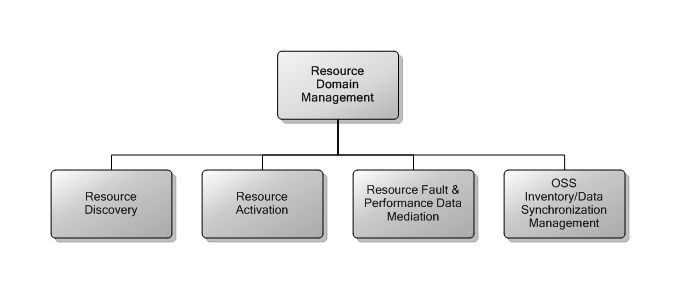

Resource Domain Management is the application area that provides the exposed resource services that are available to all other application areas, including those others in the Resource Management layer.
Domain Management’s role in Next Generation Network re-engineering is to hide the idiosyncrasies and shortcomings of the Network, IT Computing, and IT applications equipment from the rest of the OSS estate, freeing it to be agile.
This is particularly important as operators install lots of new, untried equipment with early release Element Management software.
Resource Domain Managers should be expert activators, alarm handlers, and billing mediators for their domain, but should not operate in any cross-domain capacity. It is the responsibility of the other Resource Management layer applications to perform any cross-domain functions such as forecasting, capacity planning and design, and or for co-coordinating activation, root cause analysis and performance monitoring.
The basic model is shown below and is related to the examples shown in section 4.2 TMF 516.
Relationship of Resource Domain Management to other Application Map application areas
Why Domain Management?
Domains are defined as a set of entities, in this case resources, which have a common set of policies applied to them by a manager (M. Sloman, "Policy Driven Management for Distributed Systems," J. Net. Sys. Mgmt., vol. 2, no. 4, 1994, pp. 333–60). Note that the general concept of a Domain allows for overlapping Domains, provided there are no policy conflicts. However it is likely that the Application Map will need to mandate non-overlapping Resource Domains.
The resources that need to be managed include: IT computing, IT application, and networks.
Historically Networks have been managed as a service technology specific stove pipe such as SDH and ATM i.e. the service providers have commonly imposed a policy that all SDH services will be managed by one management systems stack. In next generation networks there is a need to move away from stovepipe E2E service management stacks towards a shared resource infrastructure model for services.
A specific example in TMF516 for Networks was the proposal to use Resource Management Domains that separately manage the logical and physical aspects of:
Access Networks
Access Nodes
Intelligence Nodes
Core Network
Gateway Nodes
Applications and Content Servers
This was created from the Frameworx 16.0 Model